according to publius what is the ultimate object of government what role does statesmanship play
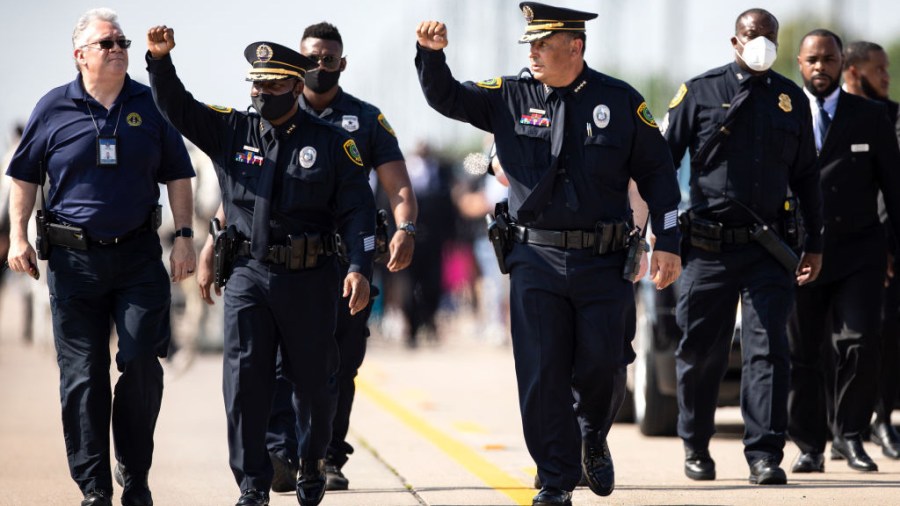
The voice of the people — at least the majority of the people — reigns supreme in a democratic society, so the people in that democracy should patently have a say in the role of a segment as essential as the police. Nosotros rely on the police force to maintain law and social club and continue citizens safe. In a perfect club, that is exactly what would happen, merely society isn't perfect, and that isn't e'er the end upshot.
Many people think incidents involving police brutality and excessive force are the natural effect of a degenerating lodge plagued with unresolved social and racial inequalities and other bug. Possibly that's true to some extent, simply it's also possible the problem could be rooted in behaviors and practices that appointment back to the starting time of policing in America. To empathise what that means, let's take a look at the history of the police in the U.S.
Colonial Night Sentinel
Although social order has always been a core component of civilized society, bodily police force forces haven't always been the say-so backside that control. Historically speaking, constabulary officers are a relatively modern invention. In the earliest days of Colonial America, most towns relied on a simple system of nighttime watchmen to prevent offense and watch out for trouble. Night watches were established as early as 1636 in Boston and 1658 in New York, mostly for the purpose of watching for nonviolent crimes like gambling and prostitution.
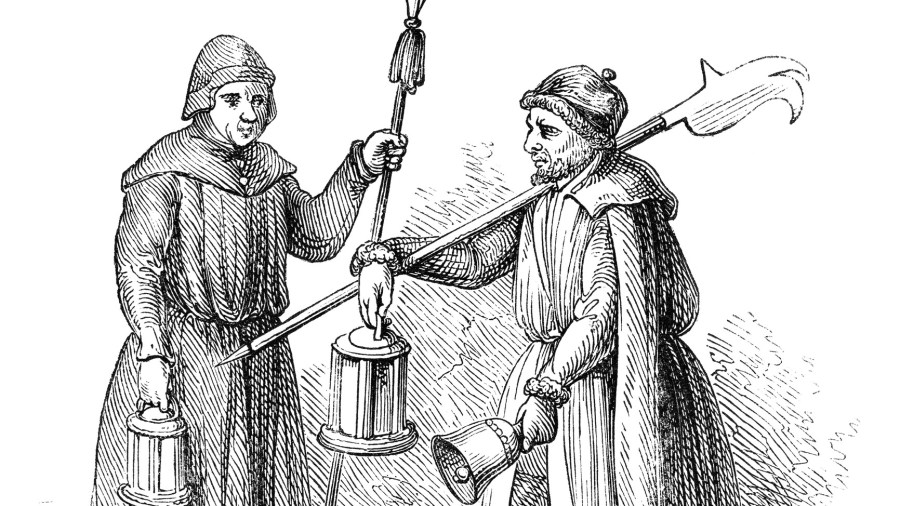
The men in the towns were obligated to participate in nighttime watches, merely many didn't want to do it and didn't take the task seriously. Some were fifty-fifty guilty of drinking or falling asleep while on duty. Wealthy residents frequently paid others to serve on the night watch in their place, and those they paid were often (ironically) criminals themselves. In some cases, serving on the night watch was assigned as a punishment.
Southern Slave Patrols
Early America was congenital on the idea of exploiting different kinds of labor. For people who settled in cities and towns in the North, it involved exploiting immigrants and the poor. For those in the Southward, it meant relying on slave labor. While dark watches dominated in the North, slave owners in the South drove the nativity of the Southern police organization past creating slave patrols to enforce laws. The patrols consisted of three to six white men armed with whips and guns.
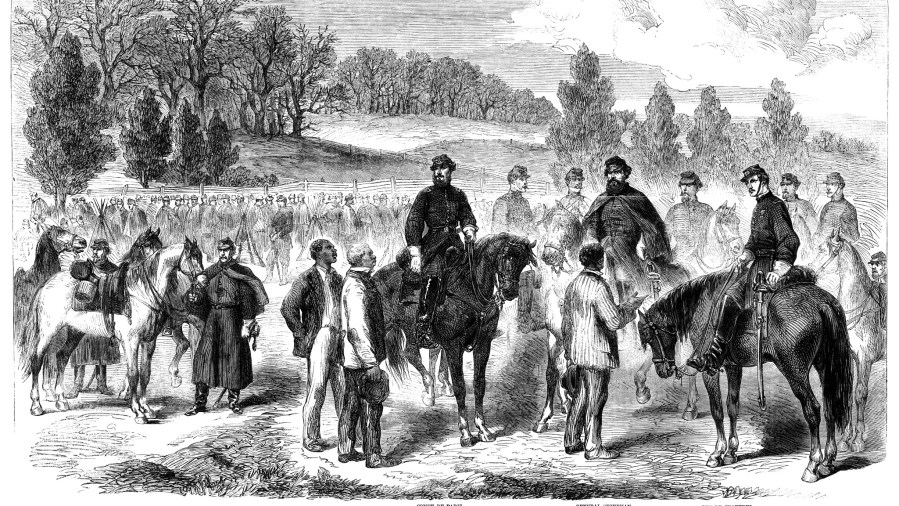
The first slave patrol was formed in the Carolina colonies in 1704 for the purpose of tracking runaway slaves and returning them to their owners. The patrolmen also used terror tactics to intimidate slaves and prevent revolts. Following the Ceremonious War, these groups largely transitioned into constabulary organizations that focused intensely on controlling freed slaves by enforcing segregation laws or vigilante groups similar the Ku Klux Klan, who operated with the sole purpose of threatening, injuring and even killing Blackness people and other minorities similar Native Americans.
Nigh all white men had to serve on slave patrols, whether they endemic slaves or not. Unfortunately, this practice created a sense of responsibility in white people that it was their duty to monitor the lives and movements of Black people. Additionally, the concept of treating enslaved people like they were holding created the imitation illusion that white people had the right to inflict physical penalization.
Nascency of the Organized Constabulary Strength
As cities began to grow larger throughout the states, night lookout man systems couldn't handle the increasing sizes. In the northern states, merchants and other types of businessmen recognized the need for a solution and settled on an idea that would take the cost of security off their shoulders and make it a public expense. Equally a result, the showtime official organized law force began operating in Boston in 1838. Similar organizations started in New York Urban center in 1845, Albany and Chicago in 1851, New Orleans and Cincinnati in 1853, Philadelphia in 1855, and Newark and Baltimore in 1857.
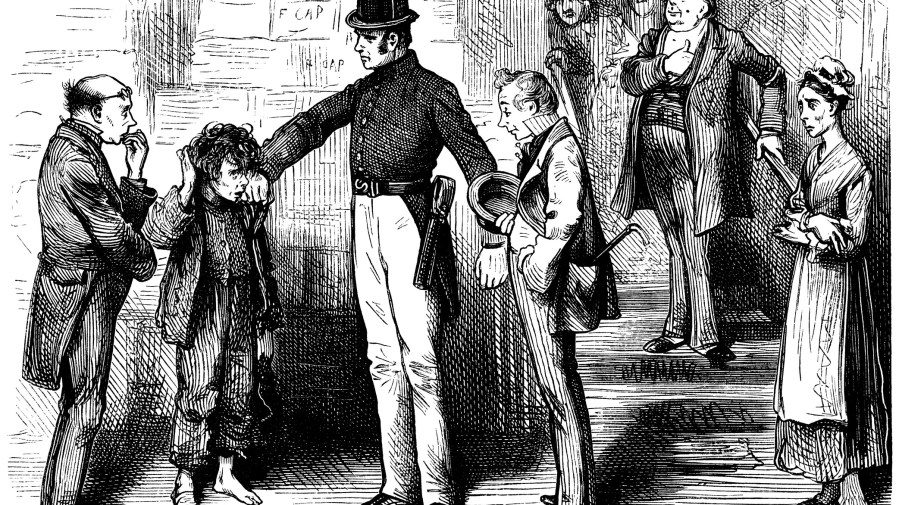
Early police forces had a few things in common with modernistic law, such as relying on public (city) funding to pay full-time officers who weren't volunteers, just they were by and large different from what nosotros meet today. Immigrants continued to cascade into the land, and many of those immigrants — Germans, Irish, Eastern Europeans, etc. — clashed with citizens who had mostly British and Dutch origins. Crime rates started to rise, and newly created police forces were tasked with putting a stop to it — with violence, if necessary.
The most powerful, wealthiest Americans controlled the actions of the police and directed them to keep immigrants, minorities and even poor white people downtrodden and "in their place" by criminalizing very minor transgressions and resorting to abuse. Their main duties should have been preventing law-breaking and maintaining social club, but they were politically and economically motivated to keep the social bureaucracy intact instead. Ultimately, all the types of early policing in the U.S. were established based on two elements: controlling slaves and controlling minorities.
Rise of the Political Era of Policing (Mid-1800s to Early 1900s)
During the Civil War, the war machine served equally the primary form of police enforcement in the South, followed by sheriffs during the Reconstruction period. The sheriffs were appointed by governors, primarily to maintain law and order in less populated areas. About were corrupt and focused more than of their attention on maintaining segregation than law and order. In the cities, police forces became increasingly common, just policing was strongly tied to politics at the time. The concept of maintaining law and order ordinarily depended on the self-interests of the most powerful individuals in the city, who determined what "club" should wait like. Local political leaders often selected police leaders, and bribes and payoffs were common.
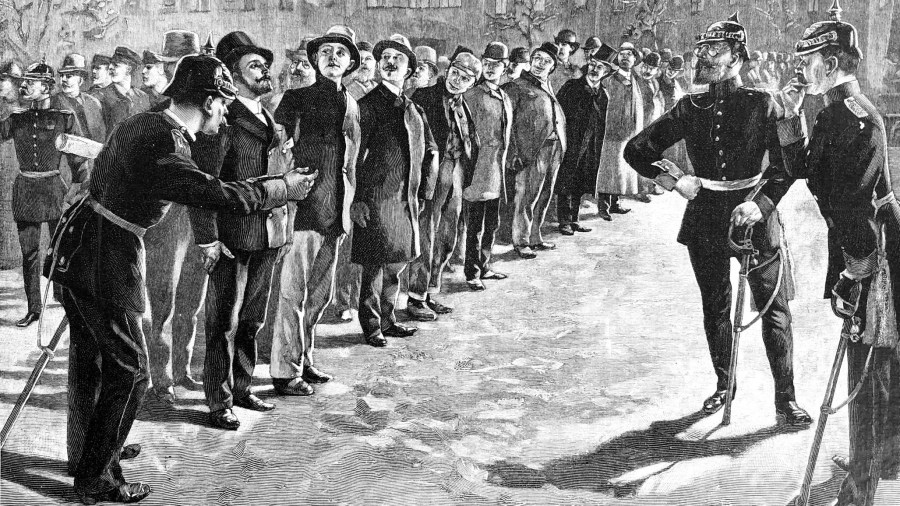
Detective units that focused on investigating crimes first started to appear in police force departments in the 1850s. Allan Pinkerton's famous group of individual detectives rose to fame during this menses equally professionals who put a stop to railroad train robberies and union strikes. Metropolis police officers also actively focused on preventing strikes after the Ceremonious State of war to preserve the financial interests of wealthy business owners, and they had no qualms about using brutal methods to force demonstrators to end.
In the mail-Civil War era, the wealthy upper class and merchants promoted the concept of "unsafe classes" of people. These classes consisted of everyone the aristocracy viewed equally inferior, which was generally poor whites, immigrants and gratuitous Blacks. Instead of post-obit logical standards of reacting to criminal offence, law officers began to focus on preventing law-breaking from ever happening past scrutinizing the dangerous classes.
During this fourth dimension, warning boxes immune business owners to alert police officers, and patrol wagons started being used to send large numbers of people arrested all at once, often those who were striking or protesting. Merchants pressured police officers to article of clothing uniforms to make them easier to spot in crowds, a exercise that still exists today. Police officers began carrying firearms during this period, even before they were officially granted permission to arm themselves.
Past the early 1900s, country police force agencies started to appear, mostly to further control workers by enforcing "public gild" laws. As a whole, police departments supported specific political allies and persecuted and arrested political enemies. Politicians were behind much of the original types of organized crime, such every bit gambling, racketeering and prostitution, and at the turn of the 20th century, law forces were piddling more than enforcers for organized crime.
Rise of the Reform Era of Policing (Early 1900s to 1960s)
At the close of the 19th century, city police officers mostly focused on policing the poor and ethnic groups deemed potentially dangerous by the elite and wealthy members of guild who were in charge. During what is known as the Great Migration, large numbers of Blacks left the Southward and rural areas and moved to large cities. As Blackness metropolis populations grew, the idea persisted that Blacks were a dangerous class and needed to be monitored — sometimes to the signal of harassment — more than than white people.
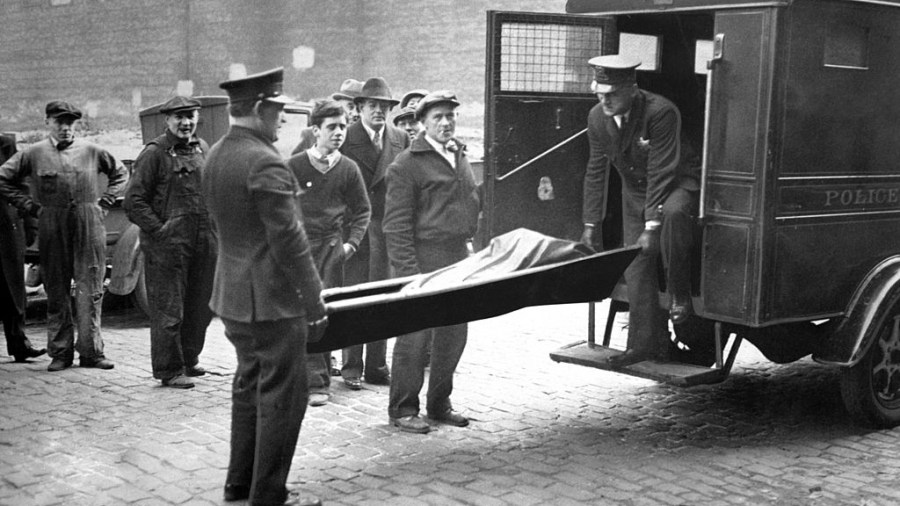
In the early 1900s, August Vollmer — often called the "begetter of modernistic policing" — recognized the problems with American policing and developed a comprehensive programme to reform the organization. His approach by and large focused on incorporating social work and psychology into policing. He besides created a separate judicial organization for juveniles and promoted the cosmos of state and federal police forces to cope with Prohibition violations and the rise of organized criminal offense. Motivated by Vollmer, police forces began to motility toward more professional codes of conduct based on much more respectable behavior.
Attempts at reform sometimes involved investigative commissions that were established to focus on specific types of criminal activities within law departments. In New York Urban center, the Lenox Committee (1894) was one of the earliest examples and focused on law extortion related to prostitution. The Curren Committee (1913) also focused on police ties to prostitution as well as gambling, while the Seabury Committee (1932) turned its attention to corruption related to Prohibition (1919-1933), a menses when speakeasies frequently popped up in major cities, and officers took bribes to ignore them.
On a national scale, President Herbert Hoover created the Wickersham Commission in 1929 to investigate illegal activities and issues with police forces all beyond the country. The commission also conducted the first investigation into organized criminal offence in America. Other prominent cities that established commissions to spearhead broad investigations during this period included Philadelphia, New Orleans, San Francisco, Atlanta and Los Angeles.
Attempts were as well fabricated to reform police departments by installing new leadership and implementing a testing organisation for promotions inside a constabulary department. Departments established specific option standards and training requirements and incorporated civil service tasks into the job description. The end result was a organization with more than bureaucracy and a clear chain of command. The new system separated constabulary from politicians and created special squads for certain types of crimes, such every bit narcotics, vice, investigations and traffic.
Landmark court cases during this period also forced specific reforms on law departments past dictating the way certain processes had to be legally handled. Due process was first addressed in Mapp five. Ohio in 1961, when a judge laid down strict rules to prevent illegal searches and seizures in criminal cases. In Escobedo v. Illinois in 1964, the judge determined a suspect is entitled to an attorney, and whatsoever statements fabricated without an attorney aren't open-door in courtroom. Mayhap the most well-known case, Miranda v. Arizona in 1966, dictates that a suspect must be informed of all rights earlier they tin can be questioned.
Police Professionalism Movement (1950s to 1970s)
At the stop of the Reform Era, a move known as law professionalism took hold in many constabulary departments across the land. O.West. Wilson first established the concepts of police professionalism in the 1950s. The move promotes military-style system with a centralized command unit and pushed for the added reach of motorized patrols instead of foot patrols.
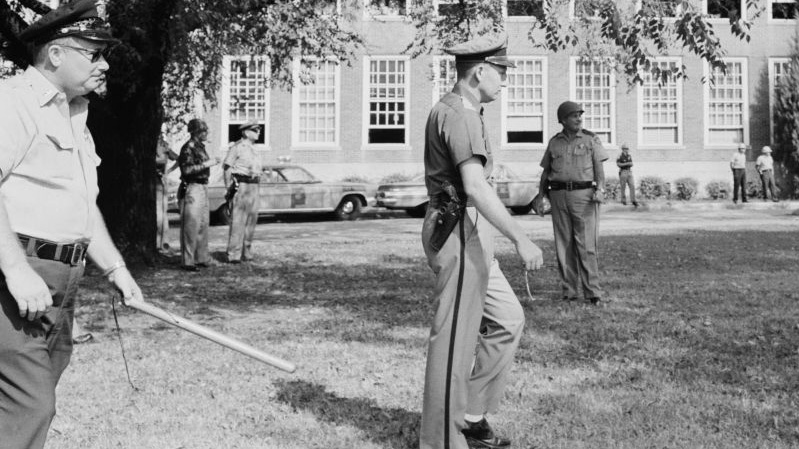
Unfortunately, many of the newly adopted procedures led to resentment of the police in many communities, partially due to racial profiling that targeted minorities as potential criminals without crusade. Officers isolated themselves from the public and were resistant to complaints and criticism. By the mid-1960s, police unions were created to protect officers. Most police force departments in large cities had a law union past the early 1970s. In addition to protecting officers, unions implemented compulsion tactics like "blue influenza" and work slowdowns to need things like pay raises and equipment upgrades.
The "Taylorization" of the police — terminology borrowed from the factory industry related to optimization — involved downsizing police forces and focusing on chore specialization. Patrols went from ii officers in a car to one, and new technology, such equally the 911 system, was implemented to help officers practise their jobs. Some of the more mundane jobs were passed off to civilians to consummate. Unfortunately, some of the measures meant to ameliorate their capabilities actually widened the divide between police officers and the public.
The relationship became even more strained when police departments used force to command protesters during the Civil Rights Move and Vietnam War protests. Many situations got out of hand, and instead of protecting the peace, police officers became a common source of social tension. Throughout the 1960s, Blacks and minorities began to protest police handling itself, engaging in everything from peaceful protests, boycotts and sit-ins to out-of-control riots, and the law response was often harsh and violent.
In 1969, the Stonewall riots lasted 6 days when the LGBTQ community fought dorsum after a police raid of Stonewall Inn in New York City. This result ultimately led to the Gay Rights Move. By the mid-1970s, the country was largely dissatisfied with policing and distrustful of police officers. To make matters worse, research studies in the tardily 1960s and early 1970s showed that police force patrols didn't prevent law-breaking, and assigning detectives to work cases didn't ameliorate rates for solving crimes.
Diversity among constabulary officers remained rare during this menstruation every bit well, with women just accounting for approximately 2% of officers in 1970 and racial or ethnic minorities accounting for less than ten%. Those numbers did eventually meliorate to 13% women and 25% minorities in 2017.
Rising of the Community Problem-Solving Era of Policing (1970s to Present)
In the 1970s, police force administrators began to recognize that police officers deal with many behaviors that aren't criminal, such as psychological behaviors and social issues. As a result, they began to focus on ways to address those problems and plough police force officers into allies instead of adversaries. Gradually, they initiated community policing strategies that chosen on communities to piece of work in conjunction with the police to command crime and solve other community issues, including those related to social issues and mental wellness.
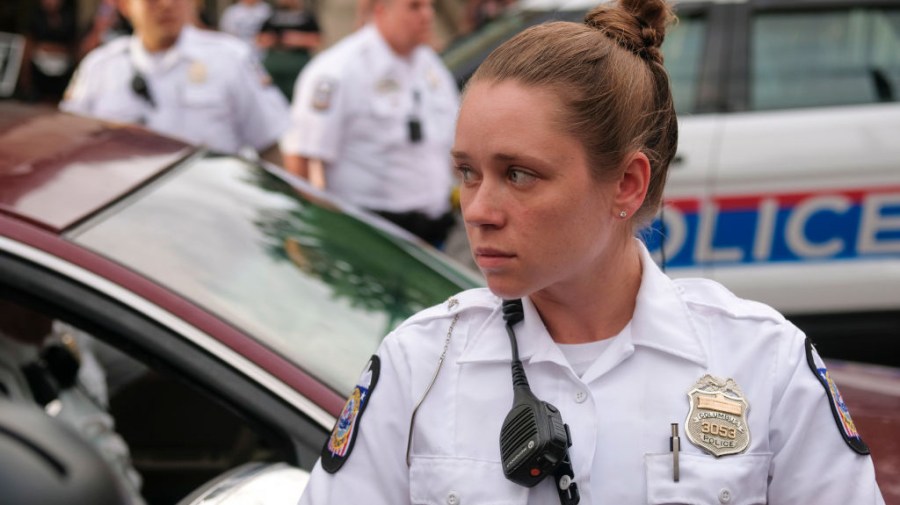
The goal of community policing is to decentralize the police so officers can establish positive relationships with their communities. If trying to control criminal offence through a constabulary presence and intimidation was unsuccessful, and then they believed collaboration and trust could be the answer. The thought is that it'south far as well difficult to control criminal offense and maintain order without a strong connection to the community.
Community policing uses resources to solve problems rather than just respond to issues as they happen. By the early 21st century, two-thirds of local police departments relied on customs policing strategies around the country for dealing with mutual local crimes and civic duties. Additionally, new specialty divisions were created as new threats appeared. The 1999 Columbine schoolhouse shooting triggered the development of new, more effective processes for handling mass shootings, for example.
In 2001, the 9/11 terrorist attacks led to the establishment of highly skilled counterterrorism units. Unfortunately, the heightened level of diligence combined with the trauma also led to increased racial profiling in some communities. Afterwards 9/11, the number of accusations regarding police brutality, excessive force and racial profiling started to increase once once again. Some highly publicized deaths led some departments to start using body cameras, but trunk cameras don't always seem to influence behavior when tensions run high.
Finding a Mode Forward
Casting officers in roles that make them part of the customs is a positive motion that has taken police departments every bit a whole in the right direction, just problems however occur at times that result in face up-offs between the police and the public. Lingering racist ways of thinking about crime that date back to the early days of policing in America could exist partially to blame. If grooming for officers still includes elements of race, religion or social class when learning how to spot suspicious deportment or a potentially dangerous person, then the grooming protocols certainly need to modify immediately.
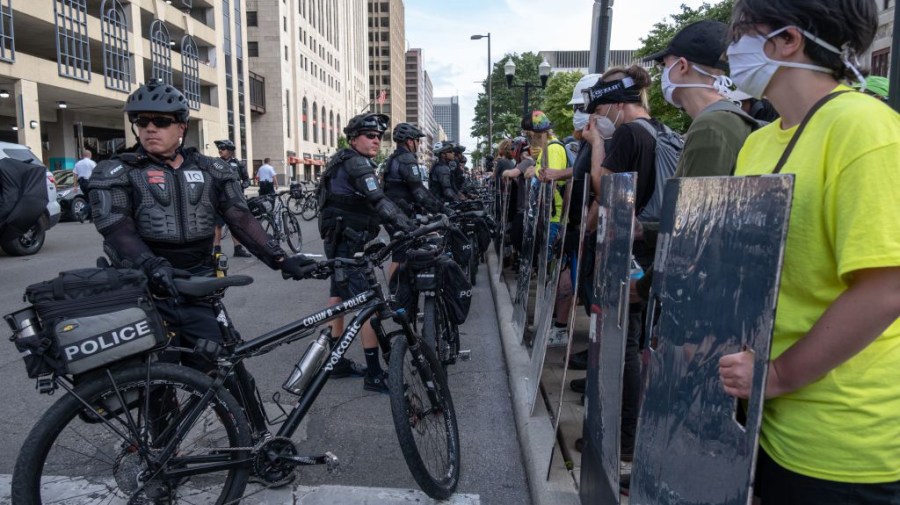
Additionally, modern police budgets swallow up all the funds that could go to services needed to assistance society, which could in plow reduce the number of people committing crimes and going to jail. More money spent on social programs versus policing could reduce damage to citizens as a whole. This is what most people have in heed when they phone call for a move to defund the law. Nearly people don't desire to eliminate the police force; they want to refocus some of the money to fund social and mental health programs to better handle individuals who create disorder but aren't criminals.
Protests all over America demand change at the least or even the elimination of the law force at the most farthermost. Speaking out against acts of police brutality is our right and our social responsibleness, simply the situation becomes more complicated when those protests lead to riots, vandalism, arson and other crimes that require police intervention for the protection of bystanders, business organization owners and property. When you look at the history of the police in the U.South., information technology'southward clear that the police accept come a long way and improved dramatically in the past four centuries, but that doesn't hateful they have fully evolved to what we need them to be. We can merely hope the recent protests ultimately lead to the continued development that will keep moving policing in a positive direction.
Source: https://www.reference.com/world-view/police-important-democratic-society-f076b4e00ea6871b?utm_content=params%3Ao%3D740005%26ad%3DdirN%26qo%3DserpIndex
0 Response to "according to publius what is the ultimate object of government what role does statesmanship play"
Post a Comment